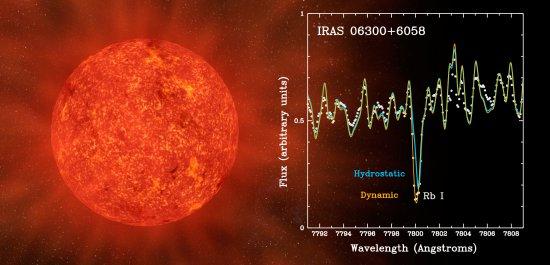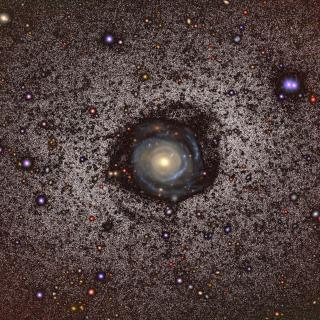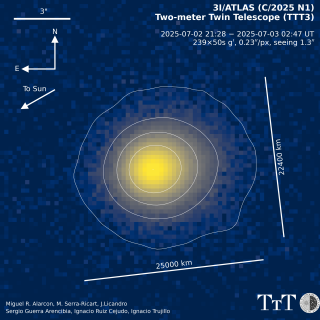Full HD Video at the end
Intermediate mass stars, in their last phases of evolution, produce a large number of heavy elements (rich in neutrons), some of them radioactive isotopes, such as those of rubidium, technetium, zirconium, yttrium, lanthanum, or neodymium. These elements are pushed outwards to the surface of the star, and afterwards released into the interstellar medium. After a number of studies of the chemical composition of these dying stars, called “AGB” stars, an international team of astronomers, led by researchers from the Instituto de Astrofísica de Canarias (IAC), has just published a new theoretical model which can explain the overabundance of rubidium observed in the most massive stars of this type. The new model includes the effects of the envelope of gas and dust which surrounds these old stars, and which had not been taken into account in previous theoretical models.
The authors of this article, published in the journal Astronomy and Astrophysics Letters, are the astrophysicists Olga Zamora and Domingo Aníbal García Hernández, researchers of the IAC and the University of La Laguna, Arturo Manchado Torres, of the IAC and the CSIC (Spanish Higher Research Council), and Bertrand Plez, of the University of Montpellier (France).
MORE INFORMATION, REFERENCE TO THE ARTICLE, VIDEO AND CONTACTS
The AGB giants.
Stars of up to eight times the mass of the Sun, towards the end of their lifetimes, go through a phase which is called the “asymptotic giant branch” (known by its initials, AGB before producing planetary nebulae, and ending up as white dwarfs. In this phase the star expands to a radius of up to thousands of times the Earth-Sun distance, swallowing any planetary system which may be around it. In so doing it cools down, but emits up to a thousand times more light than the Sun. While these stars evolve within the AGB phase, they are losing mass by emitting a stellar wind, which gives rise to a cool envelope of gas and dust around the star.
Among this type of stars, those least studied have been the more massive ones (between 4 and 8 times the mass of the Sun), which were identified for the first time in our Galaxy in 2006, in a pioneering study in which a number of the researchers of the present study also participated. Their identification was made possible by the detection of Rubidium in the spectra of these stars, and in particular of the radioactive isotope Rb-87, which was the first observational evidence that they produce major quantities of this isotope, as had been predicted by theoretical models of stellar nucleosynthesis (models of the production of the isotopes of the chemical elements in the interiors of stars) more than 40 years ago. More recently, in 2009, AGB stars were detected also in other nearby galaxies, such as the Magellanic Clouds, using the same technique.
However the high abundances of Rubidium observed in these stars were a challenge for the theoretical models, which predicted considerably smaller abundances for the isotope Rb-87.
The effect of the envelope.
As a possible cause for this disagreement between theory and observations it was noted that the model atmospheres used previously to derive the chemical abundances were not sufficiently realistic for the AGB stars, because they did not take into account the large envelopes of gas and dust which surround the central star. These circumstellar envelopes, which can be a vast as several light years in radius, can cut off the light coming from the central star in the visible wavelength range, where we find the information required to calculate the quantity of Rubidium present.
“In our work”, explains Olga Zamora, we have determined for the first time the abundance of Rubidium taking into account the effect of these envelops in a sample of massive AGB stars in our Galaxy and in the Large Magellanic Cloud. Using this method we find that the Rubidium abundances determined using the new model atmospheres reproduce the observations much better, showing that our understanding of nucleosynthesis in the massive AGB stars is essentially valid”
Given that the AGB stars account for the origin of more than 50% of all the elements in the Universe heavier than Iron, studying them has important consequences in other fields of astrophysics, such as stellar evolution, the chemical evolution of the galaxies, the origin of the globular clusters, or the chemical composition of the Solar System. “In fact”, states Domingo Aníbal García Hernandez, “the more massive AGB stars could explain the chemical anomalies observed in globular clusters and in the oldest substances found in meteorites, whose origin is the cloud from which the Solar System condensed”
REFERENCE TO THE ARTICLE
“Circumstellar effects on the Rb abundances in O-rich AGB stars”,
Accepted for publication in the journal Astronomy and Astrophysics Letters, in the edition of April 2014. (DOI: http://dx.doi.org/10.1051/0004-6361/201423626).
VIDEO: Evolution of a star until it reaches the AGB phase
- Preview and description
- Full HD (1920x1080), Quicktime H264 (.mov), 30 seconds
CONTACTS
Olga Zamora: (ozamora [at] iac.es (ozamora[at]iac[dot]es)) (+34) 922605376
Domingo Aníbal García Hernández: (agarcia [at] iac.es (agarcia[at]iac[dot]es)) (+34) 922605375



